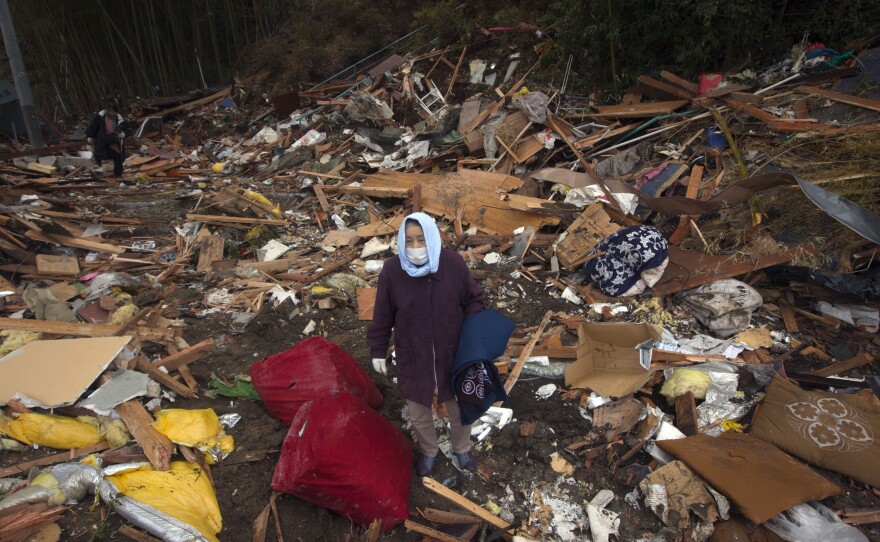Two weeks ago, Deputy Managing Editor Stu Seidel flew to Tokyo to oversee NPR's coverage of the earthquake, tsunami and nuclear accident in Japan. This past weekend, he visited northern Japan to see for himself the devastation that lined hundreds of miles of the country's Pacific coast.Along the water's edge in Rikuzentakata, on the coastline of northeastern Japan, green hills rise up to circle a placid bay. In the distance, where the bay opens to the Pacific Ocean, a warship stands sentry, as if to guard the town from any harm. The midmorning sun rises on Japan, just more than two weeks after an earthquake 45 miles offshore triggered a tsunami that swept this town, and so many like it, from existence.
Turning your back on the sea that provided a living for the people of this fishing town, a flat landscape of debris spreads out toward mountains nearly a mile away. There is little to block the view to the mountains.
The only structures still standing are built of steel or concrete. A modern hotel commands the best view over the water to the east, but it has no windows to protect against the brisk ocean breeze. Beyond the hotel, light stanchions define where a small baseball stadium once illuminated players and where stands once welcomed fans.
Across the road, with a single lane cleared to make way for emergency and recovery vehicles, two steel gas station pillars hold up a sign inviting motorists to fill up their tanks. But the gas station is gone.
A few hundred yards farther inland, two six-story concrete apartment buildings stand as the town's tallest structures. Only the windows on the top floor remain. Looking through the empty squares to the buildings' first five floors, in the distance are the remains of a school, resting at the foot of hills that shape the back of Rikuzentakata. The school was just high enough to escape complete destruction. The front is gone, opening the classrooms to the morning sunshine.
Rikuzentakata, once home to 23,000 people, is otherwise a landscape of splintered two-by-fours, upside-down boats scattered among the ruins, cars and trucks half buried in the wreckage, railroad tracks torn from their bed and twisted into a spiral, tanks from a sake brewery strewn among the debris. A pagoda-style roof, nearly intact, sits on the ground. The house it once protected from rain and snow is gone.
And all of the people are gone. Those who escaped are in shelters or at the homes of friends or relatives. Some of those who died have been found. Many others, still missing, are buried in the remains of the town or were swept out to sea as the tsunami's waters receded.
Groups of workers step carefully through the field of broken homes. They carry long poles: Gently, they probe into the debris, looking for bodies.
A dozen workers stand in an oblong circle around a stretcher, quietly looking down on the shrouded form of a person they just picked out from the remains of Rikuzentakata. In the distance, another group surrounds another form wrapped in plastic, resting on a stretcher. More than 300 people are known to have died in Rikuzentakata. As many as 10,000 more residents are still missing.
Curving up away from the sea, the narrow road crosses a line from wasteland to a place where everything stands as it was before the tsunami but where nothing is normal. A gas station, with no gas to sell, sits empty. Houses line the road that rises into the hills. Military vehicles are pulled off to one side and soldiers stand around, as soldiers do, some smoking, waiting for their next orders.
To the left, up a side road, the town's junior high school now is home to hundreds of survivors. At one end of the parking lot, workers piece together prefabricated shelters. Portable toilets stand in a line between the new trailer-like aluminum buildings and a row of trees, defining the boundaries of a new neighborhood in Rikuzentakata.
In the school's front lobby, just behind rows of cubbies to hold shoes, which must be removed before going further, a row of workers take a thousand quiet questions from a stream of newcomers and visitors. A trophy case holds mementos of athletic victories past, and a bulletin board holds page upon page of names of people living in the school's combination gymnasium/auditorium.
Family spaces are marked off by collapsed cardboard boxes, propped up by folding chairs. Yellow, orange, red, green and blue blankets and quilts provide some warmth against the room's chill.
A large flat-screen television on a stage at one side of the room shows a game in a high school baseball championship series that for many people in Japan is a small but welcome diversion from the nation's collective disaster. But few people in the gym seem to pay attention to the game. Some sleep. Some sit and stare, seemingly at nothing. Others wander the narrow paths between family spaces. Another television shows the news. Few seem to pay any attention to that, either.
The news that everybody remaining in Rikuzentakata really cares about is being tracked in another building, a short distance away. On the second floor of a warehouse, four men and women with laptop computers quietly record what is known about the missing and the dead. One wall is covered with printed pages of the names of the missing. Another holds pages with names of those known to have died. Two men and a woman scan the names of the missing. A woman stands before the names of the dead. Her eyes seem fixed in one place. Her head doesn't move.
Outside, beyond the loading dock, along the driveway to the warehouse, a few daffodils poke out of the soil, heralding the coming of the saddest springtime Rikuzentakata could ever know.





